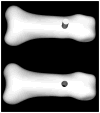Toward the development of virtual surgical tools to aid orthopaedic FE analyses
- PMID: 20376204
- PMCID: PMC2850277
- DOI: 10.1155/2010/190293
Toward the development of virtual surgical tools to aid orthopaedic FE analyses
Abstract
Computational models of joint anatomy and function provide a means for biomechanists, physicians, and physical therapists to understand the effects of repetitive motion, acute injury, and degenerative diseases. Finite element models, for example, may be used to predict the outcome of a surgical intervention or to improve the design of prosthetic implants. Countless models have been developed over the years to address a myriad of orthopaedic procedures. Unfortunately, few studies have incorporated patient-specific models. Historically, baseline anatomic models have been used due to the demands associated with model development. Moreover, surgical simulations impose additional modeling challenges. Current meshing practices do not readily accommodate the inclusion of implants. Our goal is to develop a suite of tools (virtual instruments and guides) which enable surgical procedures to be readily simulated and to facilitate the development of all-hexahedral finite element mesh definitions.
Figures






Similar articles
-
Adaptive meshing technique applied to an orthopaedic finite element contact problem.Iowa Orthop J. 2004;24:21-9. Iowa Orthop J. 2004. PMID: 15296201 Free PMC article.
-
IA-FEMesh: an open-source, interactive, multiblock approach to anatomic finite element model development.Comput Methods Programs Biomed. 2009 Apr;94(1):96-107. doi: 10.1016/j.cmpb.2008.12.003. Epub 2009 Jan 20. Comput Methods Programs Biomed. 2009. PMID: 19157630 Free PMC article.
-
Ia-FEMesh: anatomic FE models--a check of mesh accuracy and validity.Iowa Orthop J. 2009;29:48-54. Iowa Orthop J. 2009. PMID: 19742085 Free PMC article.
-
Four decades of finite element analysis of orthopaedic devices: where are we now and what are the opportunities?J Biomech. 2015 Mar 18;48(5):767-78. doi: 10.1016/j.jbiomech.2014.12.019. Epub 2014 Dec 18. J Biomech. 2015. PMID: 25560273 Review.
-
Patient-Specific Orthopaedic Implants.Orthop Surg. 2016 Nov;8(4):417-424. doi: 10.1111/os.12282. Orthop Surg. 2016. PMID: 28032697 Free PMC article. Review.
Cited by
-
Biomechanical Analysis of the Cervical Spine Following Disc Degeneration, Disc Fusion, and Disc Replacement: A Finite Element Study.Int J Spine Surg. 2019 Dec 31;13(6):491-500. doi: 10.14444/6066. eCollection 2019 Dec. Int J Spine Surg. 2019. PMID: 31970043 Free PMC article.
-
Cervical laminoplasty construct stability: an experimental and finite element investigation.Iowa Orthop J. 2011;31:207-14. Iowa Orthop J. 2011. PMID: 22096443 Free PMC article.
References
-
- Gebert A, Peters J, Bishop NE, Westphal F, Morlock MM. Influence of press-fit parameters on the primary stability of uncemented femoral resurfacing implants. Med Eng Phys. 2009;31(1):160–164. - PubMed
-
- Lee YS, Lee TQ, Keyak JH. Effect of an UHMWPE patellar component on stress fields in the patella: a finite element analysis. Knee Surg Sports Traumatol Arthrosc. 2009;17(1):71–82. - PubMed
-
- Zander T, Rohlmann A, Bergmann G. Influence of different artificial disc kinematics on spine biomechanics. Clin Biomech. 2009;24(2):135–142. - PubMed
-
- Folgado J, Fernandes PR, Jacobs CR, Pellegrini VD. Influence of femoral stem geometry, material and extent of porous coating on bone in growth and atrophy in cementless total hip arthroplasty: an iterative finite element model. Comput Methods Biomech Biomed Engin. 2009;12(2):135–145. - PubMed
-
- Completo A, Simões JA, Fonseca F. Revision total knee arthroplasty: the influence of femoral stems in load sharing and stability. Knee. 2009;16(4):275–279. - PubMed
Grants and funding
LinkOut - more resources
Full Text Sources
